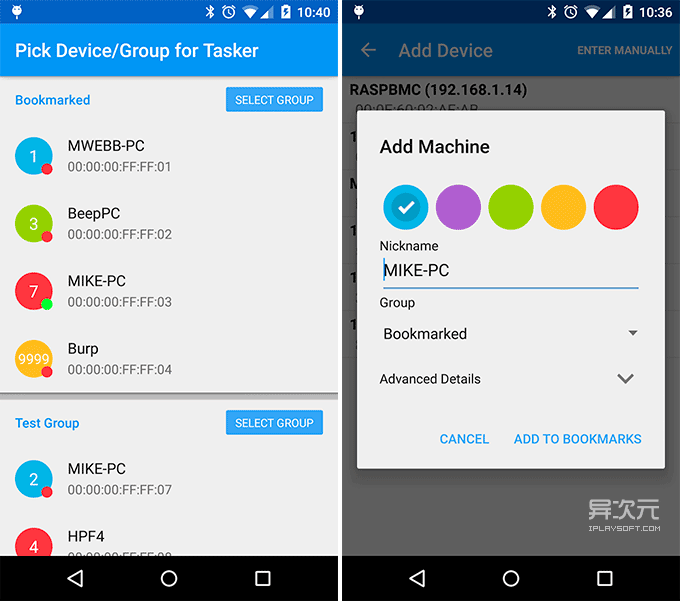

The server sends the broadcast, the client receives it and no need for other configuration. for WOL where client and server are in the same subnet there is no need for helper address. With that in mind we can see these points: if the helper address is using a remote broadcast address then the remote subnet interface probably should use the ip directed-broadcast command. And sometimes the helper address will specify the broadcast address of the remote subnet (as in your post). sometimes the helper address will specify a specific host address so the broadcast will be forwarded to that host (as in the suggestion from Paul). If you want to forward some other protocol (such as WOL) you need to use the forward protocol command to specify the protocol port whose broadcast will be forwarded. There is a small number of ports for which it forwards by default (tftp and netBIOS being some of them). helper address doesn't forward all broadcasts. It takes a local broadcast and makes a copy which it sends to a remote subnet. some times we want an exception to that rule. So a router (or layer 3 switch) will not forward a broadcast to a remote subnet. Here is a quick review which I hope will help your understanding. Helper address is needed for remote addresses not for local addresses. On gi0/1.1 you have a helper address pointing to the local IP. But if the server is remote then communication to and from the server are unicast. DHCP does use a local broadcast to find the server. directed-broadcast is used when a packet addressed to the local broadcast address is received from a remote source. You seem to associate directed-broadcast with DHCP. And if would not be needed if you were forwarding to a remote host address rather than a remote subnet broadcast address. It is not needed on the interface where the server is connected.
#WOL WAKE ON LAN SETTINGS CODE#
(On some platforms and some versions of code it is enabled by default but on many it is not, so it is safer to go ahead and configure it). Ip directed-broadcast may be needed on interfaces where clients are connected. You will probably need to configure forward-protocol for that port on the device that does routing for the server. You need to find out what port your server uses. 7 and 9 are common but others can be used. There are many ports that can be used for WOL. But when they are in different subnets you do need to be concerned. If the client and the server are in the same subnet you don't need to be concerned about the port number. I agree that organizing so that vlan x corresponds to subnet .0 is very helpful. I have it working on the same vlan (vlan 2), across two switches btw (client on one switch, sever/workstation on the other) Ip forward-protocol udp 7 or ip forward-protocol udp 9 ? (I tried 7, that didn't work.) So on the router, what I am missing, is either a (or both) On gi0/1.1, where the server/workstation is that sends the packet (ip addr 192.168.1.110) itended for waking up a machine with IP 192.168.2.117, the configuration is this: On the router, this is what the configuration for the interface with 192.168.2.0 looks like: Ip directed-broadcast I have 'ip directed-broadcast' on all interfaces that have hosts in the corresponding vlan that boot using dhcp (dhcp running on the 2900 router) From what I read some hardware uses 7/echo and some uses 9/discard? So shouldn't I use both, just in case? I alway thought that either 7 or 9 was used (I thought it was a broadcast though, so it wouldn't matter). Yes, 192.168.2.0 is the subnet for vlan2 (I am organizing stuff in separate subnets/vlans and associate .0 with vlan x, easier to keep track of that way.))

The next ste is that, of course, I would like to send a wake up packet from a different vlan to the same machine I want to wake up.Īre there some udp/broadcast settings that by default come with vlan1, but not necessarilly with other vlans? So what else is needed to be able to send a a WOL packet to a machine where the sender and receiver of the WOL packet are on a port configure like above.

I moved the client the machine I want to wake up, to vlan 2, it being a native vlan on that port:Īnother machine on a port with the same settings as above, should be able to wake the machine up, since it is in the same vlan(s) correct? (Of course it doesn't else I'd wouldn't be writing this ost). I assume that just works, because the machines are both on vlan 1, the native untagged default vlan. I was able to remotely wake up a computer (using RHEL/Centos ether-wake). I used to have a machine on a port with the "default settings" and also a work station, on a different (both 2960s) switch but also connected to a default port.


 0 kommentar(er)
0 kommentar(er)
